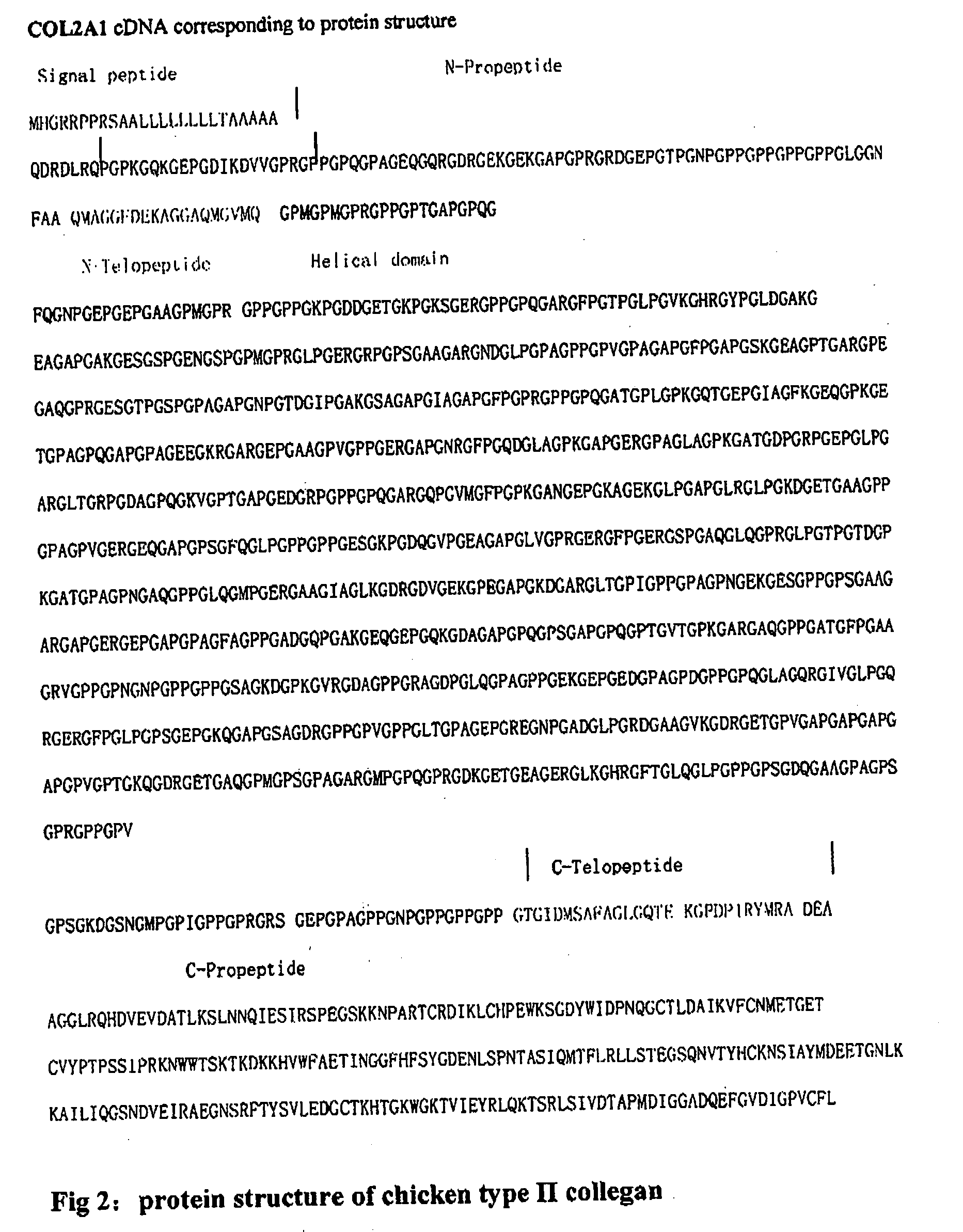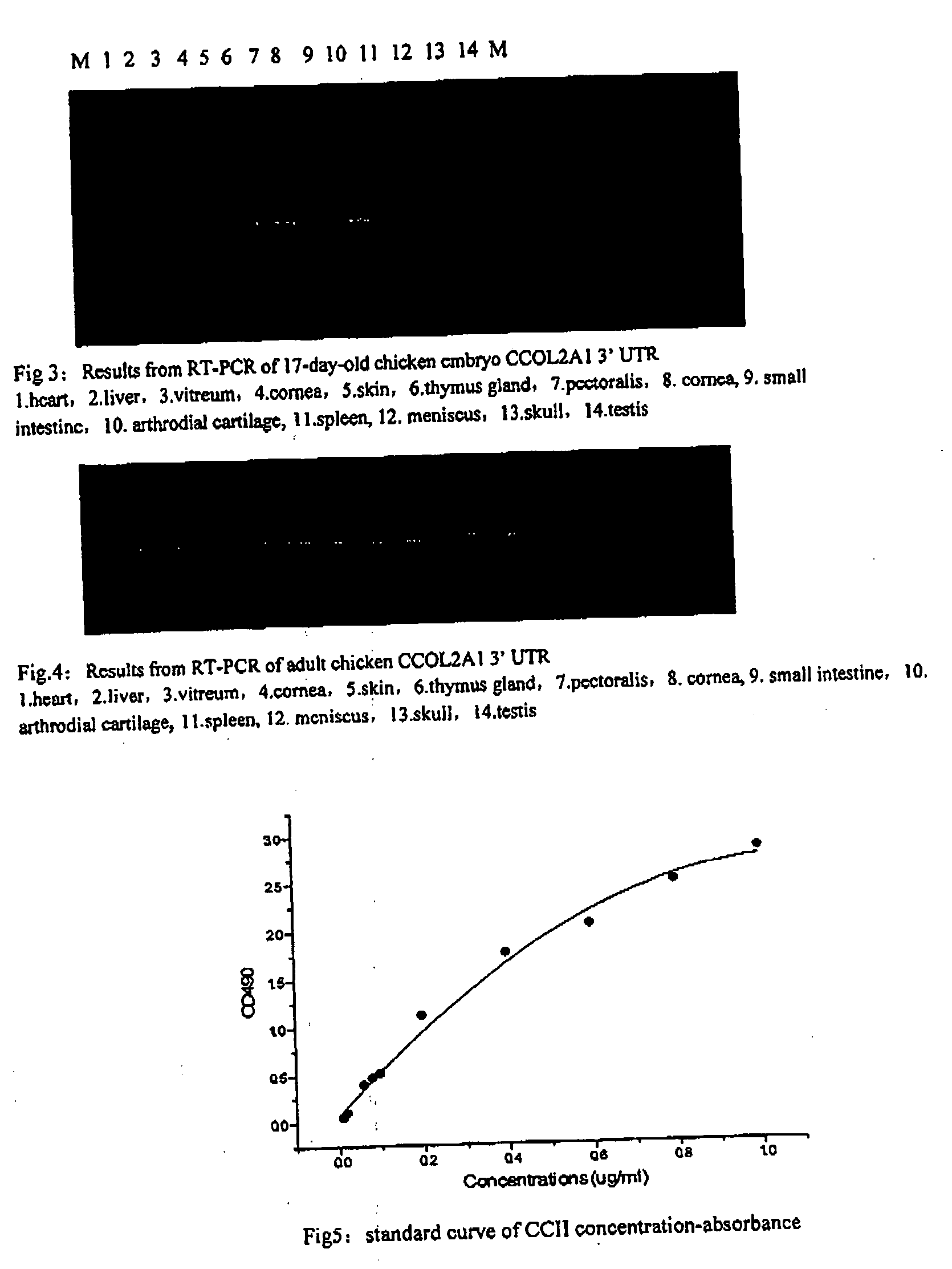Full length polynucleotide coding chicken type II collagen and the use of it
a full-length, collagen technology, applied in the field of nucleic acid molecules, can solve the problems of serious threat to the health of the afflicted individual, treatment is far from the ultimate goal of preventing joint injury, and it is difficult to guarantee a consistent and continuous curative
- Summary
- Abstract
- Description
- Claims
- Application Information
AI Technical Summary
Benefits of technology
Problems solved by technology
Method used
Image
Examples
example 1
Total RNA Extraction from Chicken Embryo Sternum
[0081] After the eggs had been sterilized, 17-day old SPF chicken embryos (Institute of Animal Sciences, Chinese Academy of Agricultural Sciences) were harvested and washed in cold saline. The sterum was isolated and grinded in TRIzol reagents on ice, followed by incubation in 1.5 ml eppendorf tube at room temperature for 10 min, centrifugation at 1000×g for 10 min at 4° C.
[0082] The supernatant was transferred to a DEPC-treated eppendorf tube. To each tube was added 200 μl chloroform, followed by extraction mixture, incubation at room temperature for 10 min, and centrifugation at 1000×g for 10 min at 4° C.
[0083] The aqueous phase was transferred to a new eppendorf tube. To each tube was added the same volume of isopropanol, followed by incubation at room temperature for 10 min, centrifugation, washing with 75% ethanol, Rnase-free water dissolving and storage at −80° C. for reverse transcription.
cDNA Synthesis
[0084] cDNA was synt...
example 2
Preparation Chicken Genomic DNA
[0158] Chicken genomic DNA was extracted using a Wizard genomic DNA purification kit (Promega) according to the manufacturer's instructions. The purity of the extracted DNA was 1.6-1.8 of 260 / 280 OD value using a spectrophotometer (BECKMAN, DU®640).
PCR-Based Cloning and Library Screening of Chicken CCOL2A1 Genomic DNA
[0159] PgF and PgR were used as sense and antisense primers for CCOL2A1 C-terminal cloning. The sequences of primers were as follows: PgF 5′ CCA GGC AAG GAT GGC GCA CG 3′; PgR 5′CCT GAT CGG CTC CGC CAA TGT CCA TAG G 3′. PCR of CCOL2A1 genomic DNA was performed using LA Taq polymerase in GC buffer. PCR products were examined by 0.8% agarose gel electrophoresis, target gene fragments were recovered from gel slices using a gel extraction kit, and inserted in pGEM-T vetors. The inserts were identified by restriction enzyme digestion and sequencing. Due to the high OC content in the CCOL2A1 genomic DNA and polyT structure, fragment cloning ...
example 3
CHICKEN CCOL2a1α1 (II) SPECIALLY EXPRESSION IN TISSUES
CCOL2A1 Expression Spectrum in the Chicken Embryo
[0164] CCOL2A1 3′ UTR was confirmed to specially belong to CCOL2A1 via Blast database searching. Therefore, the CCOL2A1 cDNA 3′UTR was used as an amplifying subject to investigate α1 (II) expression in the developing chicken embryo. Heart, liver, vitreum, cornea, skin, pectoralis, sternum and etc. in 17-day old chicken embryo were analyzed using RT-PCR. The primers were col2a1-1F and col2a1-1R, listed in Table 1. The PCR products were inserted into a pGEMT-easy vector and sequenced after restriction enzyme digestion. Simultaneously, GAPDH was amplified as an internal control using the primers PFGAPDH 5′ GC AGA GGT GCT GCC CAG AAC 3′; PRGAPDH 5′ TCA CTC CTT GGA TGC CAT GTG 3′ to generate a 412 bp GAPDH fragment.
[0165] Using the results obtained from the RT-PCR of 17-day-old chicken embryo CCOL2A1 3′ UTR, chicken embryo CCOL2A1 mRNA was expressed in heart, liver, vitreum, cornea,...
PUM
| Property | Measurement | Unit |
|---|---|---|
| incubation time | aaaaa | aaaaa |
| temperature | aaaaa | aaaaa |
| temperature | aaaaa | aaaaa |
Abstract
Description
Claims
Application Information
 Login to View More
Login to View More - R&D
- Intellectual Property
- Life Sciences
- Materials
- Tech Scout
- Unparalleled Data Quality
- Higher Quality Content
- 60% Fewer Hallucinations
Browse by: Latest US Patents, China's latest patents, Technical Efficacy Thesaurus, Application Domain, Technology Topic, Popular Technical Reports.
© 2025 PatSnap. All rights reserved.Legal|Privacy policy|Modern Slavery Act Transparency Statement|Sitemap|About US| Contact US: help@patsnap.com



